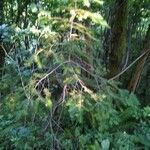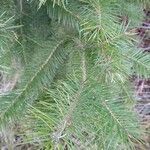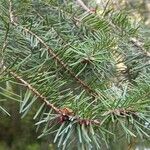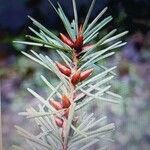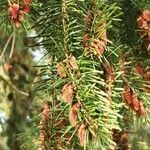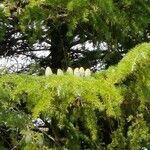Trees to 100 m tall; trunk to 4 m d.b.h. in native range; bark dark gray-brown or blackish green, smooth, with resin blisters, aging rough and scaly with deep longitudinal fissures; branchlets initially light yellow, becoming red-brown when dry, slightly pubescent. Leaves dark green adaxially, linear, 1.5-3 cm × 1-2 mm, stomatal bands 2, abaxial, white, apex obtuse or acuminate. Seed cones brown, glossy, ellipsoid-ovoid, ca. 8 × 3.5-4 cm. Seed scales ± rhombic, 2-2.5 × 2-2.5 cm, as long as or longer than wide. Bracts exserted, longer than seed scales, cusp straight or reflexed, 6-10 mm, tapering at apex, lateral lobes wide and short, denticulate at margin.
An evergreen tree. It can grow 100 m tall. The trunk can be 4 m across. The bark is dark grey-brown. It is smooth. It becomes rough and scaly with age. Older trees have long trunks without branches. Young trees are cone shaped with main branches in rings. The leaves are dark green above. They are 1.5-3 cm long by 1-2 mm wide. They are white underneath. The leaves remain of the tree for 5-8 years. The needles are single and arranged in spirals along the twig. The seed cones are brown. They are oval and 8 cm long by 3.5-4 cm wide. They hang down on stout stalks. The scales are broad and rounded. They are leathery. The seeds drop then cones are later shed.
Trees to 90(--100)m; trunk to 4. diam.; crown narrow to broadly conic, flattened in age. Twigs slender, pubescent, becoming glabrous with age. Leaves 15--30(--40) × 1--1.5mm, yellow-green to dark or bluish green, apex obtuse to acute. Pollen cones yellow-red. Seed cones 4--10 × 3--3.5cm. Seeds 5--6mm, wing longer than seed body.
